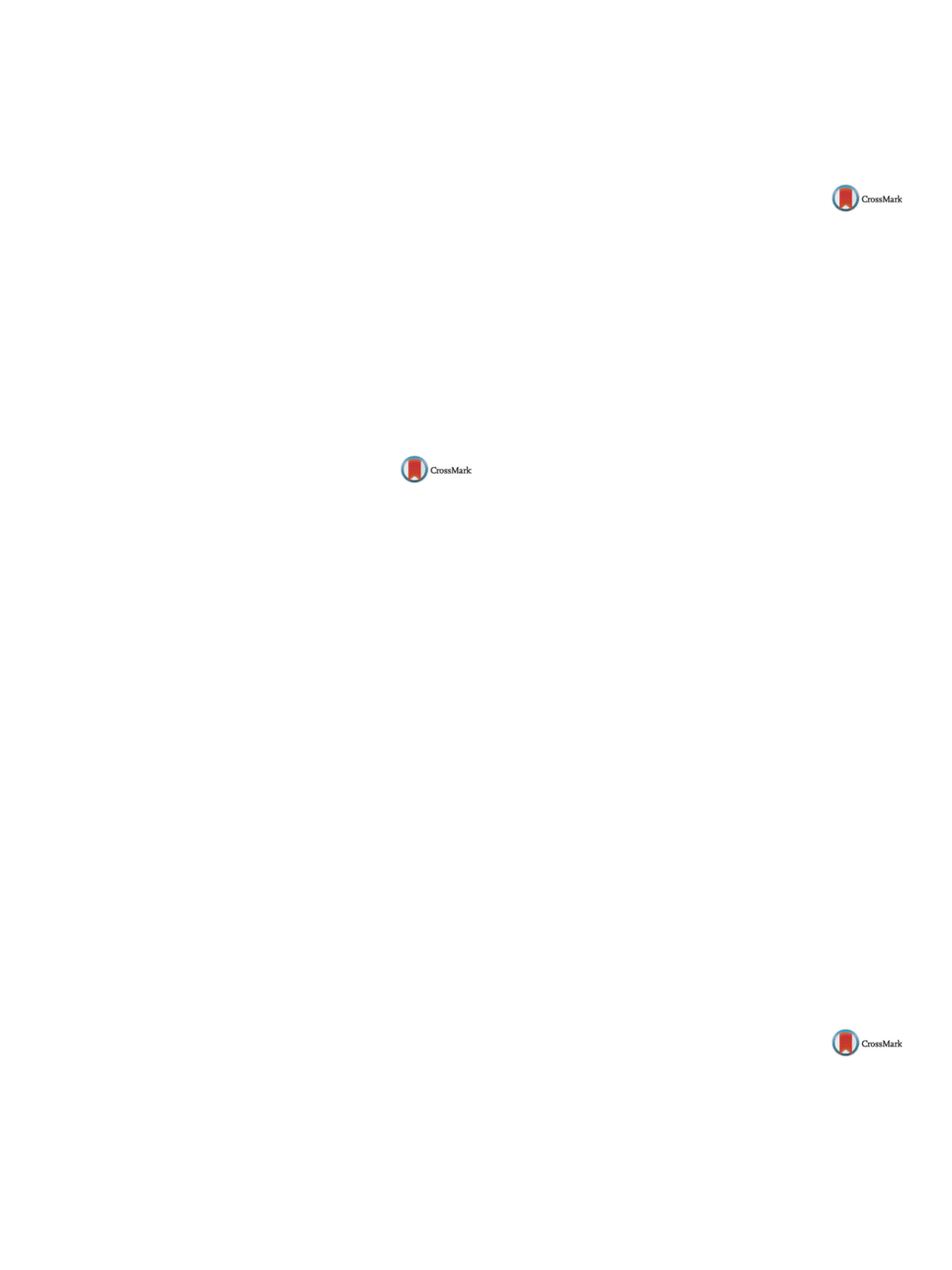

25th European Congress of Psychiatry / European Psychiatry 41S (2017) S106–S169
S111
group (Pregabalin + antidepressant, 21 patients). Patients also had
comorbid diagnoses as follows: F 41.1, F 32, F 33 or F 34. Assess-
ment was done by 100mm Visual analogue scale (VAS) and by
Clinical Global Impression Scale (CGI). Within both groups there
was a statistically significant improvement measured by VAS and
CGI scales in all repeated measurements, except for the CGI scale
in both groups between the second and ninth month where there
was no statistical difference. There were no statistically significant
differences between CG and EG on both scales either in the begin-
ning or in repeated measurements. There was no difference in the
effects of the drugs between EG and CG on both scales- VAS & CGI.
Pregabalin as mono or as an adjuvant therapy had equally good
efficiency in patients with SD who had partial response on various
antidepressants therapy after long-term treatment.
Disclosure of interest
Results from part of this trial were pub-
lished as abstract in european psychiatry, Volume 30. Supplement
1, 28–31 March 2015, Pages 534 – “Somatoform Disorders-a
New Target for Pregabalin”,
http://dx.doi.org/10.1016/S0924-9338(15)30418-1.
http://dx.doi.org/10.1016/j.eurpsy.2017.01.1884EW0016
Dissociation and therapy of depressive
and anxiety disorders with or without
personality disorders
J. Prasko
1 ,∗
, A. Grambal
1, Z. Sigmundova
1, P. Kasalova
1,
D. Kamaradova
1, K. Vrbova
1, M. Ociskova
1, M. Holubova
1,
K. Latalova
1, M. Zatkova
2, M. Slepecky
2, A. Kotianova
21
University Hospital Olomouc, Department of Psychiatry, Olomouc,
Czech Republic
2
Faculty of Social Science and Health Care- Constantine the
Philosopher University in Nitra, Slovak Republic, Department of
Psychology Sciences, Nitra, Slovak Republic
∗
Corresponding author.
Objective
Goal of the study was to analyze the impact of dis-
sociation on the treatment of the patients with anxiety/neurotic
spectrum and depressive disorders, and with or without personal-
ity disorders.
Methods
The sample consisted of inpatients who met the ICD-
10 criteria for the Depressive disorder, Panic disorder, GAD, Mixed
anxiety-depressive disorder, Agoraphobia, Social phobia, OCD,
PTSD, Adjustment disorders, dissociative/conversion disorders,
Somatoform disorder or other anxiety/neurotic spectrum disor-
der. The participants completed Beck Depression Inventory, Beck
Anxiety Inventory, subjective version of clinical global impression-
severity, Sheehan Patient-Related Anxiety Scale, and Dissociative
Experience Scale, at the start and the end of the therapeutic pro-
gram.
Results
The total of 840 patients with anxiety or depressive
spectrum disorders, who were resistant to pharmacological treat-
ment in outpatients basis and were referred for hospitalization
for the six-week complex therapeutic program, were enrolled in
this study. Six hundred and six of themwere statistically analyzed.
The patients’ mean ratings on all measurements were significantly
reduced during the treatment. The patients without comorbid
personality disorder improved significantly more than patients
with comorbid personality disorder in the reduction of depres-
sive symptoms. However, there were no significant differences in
change of anxiety levels and severity of the disorder between the
patients with and without personality disorders. The higher degree
of dissociation at the beginning of the treatment predicted minor
improvement. The higher therapeutic change was connected to the
greater reduction of the dissociation level.
Conclusions
Dissociation presents an important factor influenc-
ing treatment effectiveness in the treatment-resistant patients
with anxiety/depression with or without personality disorders.
Disclosure of interest
The authors have not supplied their decla-
ration of competing interest.
http://dx.doi.org/10.1016/j.eurpsy.2017.01.1885EW0017
Pharmacogenetic association between
glutamatergic genes and sri treatment
response in obsessive compulsive
disorder
T. Shukla
1 ,∗
, R.M.J. Jabeen Taj
2, K. Kulkarni
3, P. Shetty
4,
B. Viswanath
3, M. Purushottam
3, Y.C. Reddy
3, S. Jain
31
King George’s Medical University, Psychiatry, Lucknow, India
2
Centre de Recherche du CHU Sainte-Justine, université de Montréal,
Montreal, Canada
3
National Institute of Mental Health and Neurosciences, Psychiatry,
Bangalore, India
4
Cairns and Hinterland Hospital and Health Service, Psychiatry,
Melbourne, Australia
∗
Corresponding author.
Introduction
Pharmacogenetic studies in obsessive-compulsive
disorder (OCD) primarily focussing on serotonergic and dopami-
nergic polymorphisms, provided inconsistent findings. There is
recent evidence for glutamatergic abnormalities in OCD.
Aims
Examine the association glutamatergic genes with sero-
tonin reuptake inhibitor (SRI) response in OCD.
Objectives
To study pharmacogenetic association between
SLC1A1 and GRIN2B polymorphisms with SRI response in OCD.
Methods
DSM-IV OCD patients were recruited from a specialty
OCD clinic and evaluated using the Yale-Brown obsessive compul-
sive scale (YBOCS), Mini International Neuropsychiatric Interview
(MINI) plus, Clinical Global Impression scale (CGI). They were
subsequently reassessed with YBOCS and CGI. To study extreme
phenotypes, we included only full responders (> 35% YBOCS
improvement and CGI-I score of 1 or 2) to any SRI (
n
= 191) and
non-responders (< 25% YBOCS improvement and CGI-I score
≥
4)
to adequate trial of at least two SRIs (
n
= 84). Partial responders
were excluded. Genotyping was performed using an ABI9700 PCR
machine.
Results
Genotype frequencies did not deviate significantly from
the values predicted by the Hardy-Weinberg equation. Case-
control association analyses revealed no significant association
between genotype/allele frequencies with SRI response.
Conclusion
Our data does not show any association between
polymorphisms in glutamatergic genes and SRI response in OCD
though such associations have been found in other studies. More
SNP’s in the same gene could be responsible for the pharma-
cogenetic associations. More homogenous sample considering
symptom dimensions and other phenotypic variables may be
needed. It may be critical to go beyond “usual suspect” candi-
date gene research. In this regard, a novel approach to identify SRI
response biomarkers is the use of cellular models.
Disclosure of interest
The authors have not supplied their decla-
ration of competing interest.
http://dx.doi.org/10.1016/j.eurpsy.2017.01.1886EW0018
Long term effect of cognitive
behavioral therapy in patients with
health anxiety
K.E. Veddegjaerde
University of Bergen, Klinisk Institutt 2, Ålesund, Norway
Introduction
Cognitive-behavioral therapy (CBT) has been found
to be an effective treatment of excessive health anxiety (HA), but
the long-term effect over 18months has not been examined.


















